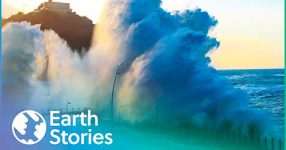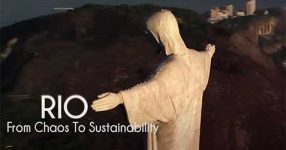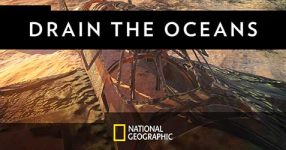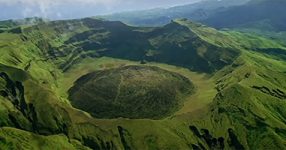In the documentary “Desperate Hours: Volcanoes & Earthquakes” viewers are taken on a gripping journey through some of the most devastating disasters of the last century. One such catastrophe unfolded in Montserrat, a Caribbean paradise turned into hell on earth by the sudden awakening of the Sufria Hills volcano. Despite geologists believing it was inactive, the volcano erupted in July 1995, burying the capital city of Plymouth under several meters of volcanic material. The once vibrant town was transformed into a desolate landscape, marking a tragic chapter in Montserrat’s history.
The aftermath saw a significant evacuation, with the island’s population plummeting from twelve thousand to four thousand five hundred. Unfortunately, the fury of the volcano was far from over. Two years later, in June 1997, a new explosion claimed lives, reinforcing the destruction caused by hot lava flows that gradually buried Plymouth. The resilient inhabitants, left with destroyed homes and a changed landscape, hoped that the worst was behind them, but the scars of Montserrat’s volcanic fury were etched into their lives.
Iceland’s Land of Ice and Fire: Unpredictable Eruptions
Iceland, known as the land of ice and fire, witnessed its own share of disaster on January 21, 1973. The documentary recounts the story of an unexpected volcanic eruption that shook the island, catching its residents off guard. The eruption, accompanied by volcanic dust falling on houses, led to the evacuation of citizens, fortunate due to a previous storm that kept fishing boats in the harbor. Lava streams flowed through the streets, causing chaos and uncertainty among the population.
The unpredictability of volcanic activity left residents stranded, unsure of when the disruption would cease. The aftermath left behind a bubbling hell of volcanic ash, solid lava, mud, and water, creating a lethal mixture that swept down the mountain slopes. This episode explores the challenges faced by those affected and the lingering impact of a natural disaster that disrupted lives for an extended period.
Murapi’s Wrath: Indonesia’s Most Dangerous Volcano
The journey into volcanic disasters takes viewers to Indonesia, where Murapi volcano, meaning “fire mountain” in the local language, poses a constant threat. With frequent eruptive episodes, Murapi has a history of deadly eruptions, with the 2010 eruption claiming over 300 lives. The documentary delves into the challenges faced by scientists trying to understand Murapi’s activity, emphasizing the importance of studying past eruptions to prevent future catastrophes.
The devastating explosions during the 2010 eruption left survivors without homes and belongings. The uncertainty of Murapi’s future eruptive styles presents a challenge for scientists, who strive to unlock the secrets behind its activity. The documentary captures the resilience of those affected and the ongoing efforts to prevent further tragedies on the hazardous slopes of Murapi.
Niragongo’s Looming Threat: Africa’s Active Volcano
Niragongo, one of the most active volcanoes on Earth, is highlighted in the documentary for its unique lava crater lake and highly liquid lava. Despite scientists monitoring its present activity, the potential for a super volcano eruption remains a haunting possibility. The documentary concludes with a sobering reminder of the high stakes involved, as an eruption of this magnitude could lead to widespread death and catastrophic consequences for millions.
In recounting the volcanic disasters of the last 100 years, the documentary provides a riveting exploration of the Earth’s unpredictable and destructive forces. It underscores the resilience of communities facing such crises and the ongoing efforts to understand and mitigate the impact of volcanic eruptions.
Earthquake Horrors: Nepal, Chile, and Pakistan
Shifting focus to earthquakes, the documentary explores the sheer destructive energy unleashed by seismic shifts. Nepal’s devastating earthquake in 2015, the Chilean earthquake of 1960, and Pakistan’s earthquake in 2005 serve as poignant examples. The catastrophic events left entire villages flattened, centuries-old buildings obliterated, and hundreds of thousands of people homeless.
The aftermath of earthquakes extends beyond physical destruction, with survivors grappling with the loss of homes, loved ones, and a sense of security. Aid efforts, logistical challenges, and the resilience of affected communities are portrayed vividly. The documentary reflects on the global impact of earthquakes and the desperate hours faced by those caught in the seismic upheavals.
The Underlying Forces: Understanding Earth’s Tremors
To comprehend the root causes of earthquakes, the documentary delves into the Earth’s composition, emphasizing the role of tectonic plates and their movements. The interconnectedness of geological plates, particularly within the ring of fire around the Pacific Ocean, becomes a focal point. The narration touches on the efforts of scientists to understand the physics of earthquakes, acknowledging the challenges and limitations in predicting these natural disasters.
The historical context of seismic events, from the 1960 Chilean earthquake to the recent earthquake in Nepal, showcases the enduring impact on communities and the global response to such disasters. The documentary concludes with a reflection on humanity’s resilience in the face of nature’s formidable forces, underscoring the preciousness of life amid the constant awareness of potential catastrophe.
Desperate Hours and Resilient Humanity
As the documentary “Desperate Hours: Volcanoes & Earthquakes” unfolds, it paints a vivid picture of the Earth’s tumultuous history. From Montserrat’s volcanic devastation to Murapi’s ongoing threat and the seismic horrors in Nepal, Chile, and Pakistan, viewers are taken on a journey through desperate hours faced by communities around the world. The resilience of humanity, coupled with ongoing scientific efforts to understand and mitigate these natural disasters, forms the overarching theme. Ultimately, the documentary serves as a stark reminder of the delicate balance between life and the unpredictable forces of nature that shape our world.












